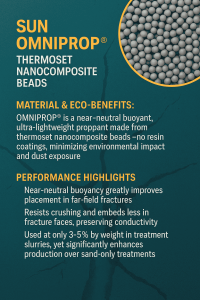Background & Innovation
-
Challenge in Conventional Proppants:
Traditional frac sand tends to settle quickly in fractures due to higher specific gravity, leaving large sections unpropped. Resin-coated or ceramic proppants provide more strength, but they are heavier, costlier, and environmentally taxing. -
Solution – OMNIPROP®:
SUN Specialty Products developed OMNIPROP®, a thermoset nanocomposite bead engineered as an ultra-lightweight proppant (ULWP). Unlike resin-coated sands, OMNIPROP® is inherently lightweight, does not rely on coatings, and is non-toxic, dust-minimized, and eco-conscious.
Material & Environmental Benefits
-
Composition: Thermoset nanocomposite beads with near-neutral buoyancy (Apparent Specific Gravity ~1.06).
-
Eco-advantages:
-
Free of resin coatings → avoids dust hazards and resin degradation by-products.
-
Requires smaller volumes (3–5% by weight) compared to sand-only designs.
-
Recyclable handling and reduced transport intensity due to lightweight nature.
-
Performance Characteristics
-
Near-Neutral Buoyancy
-
Unlike sand (ASG ~2.65), OMNIPROP® remains suspended in slickwater and brine for longer periods.
-
Ensures better far-field transport, reaching distal portions of fractures where sand cannot.
-
-
Strength & Durability
-
High crush resistance, retaining fracture width at closure stresses.
-
Minimal embedment in fracture faces, preserving conductivity (tested up to ~12,500 psi and 325°F).
-
-
Conductivity Retention
-
Laboratory flow tests confirm superior conductivity retention compared to both sand and resin-coated proppants.
-
Field Application & Results
Trial Location:
-
Andrews County, Texas – San Andres Formation (carbonate reservoir).
Design & Mix:
-
Wells completed using slickwater + sand with 2–5% OMNIPROP® blended by weight.
-
Example: ~7,500 lb OMNIPROP® mixed with ~250,000 lb frac sand.
Results:
-
Fracture Area Coverage:
-
Sand-only: ~25% effective propped area.
-
Sand + OMNIPROP®: ~85% propped area.
-
-
Production Impact:
-
Average 30% increase in first-year cumulative oil production compared to offset sand-only wells.
-
In some wells, uplift exceeded 50,000 additional barrels within the first year.
-
-
Operational Ease:
-
Pumped as standard slurry with no special equipment required.
-
No handling or safety issues reported due to dustless, non-resin composition.
-
Read Also: Proppants Market
Comparative Advantages
| Factor | Sand | Resin-Coated Sand | Ceramics | OMNIPROP® ULWP |
|---|---|---|---|---|
| Density (ASG) | 2.65 | 2.5–2.6 | 3.2–3.6 | ~1.06 |
| Transportability | Poor (settles fast) | Moderate | Poor (heavy) | Excellent (buoyant) |
| Conductivity Retention | Low at closure stress | Moderate | High | High & stable |
| Environmental Impact | Dust exposure, mining intensity | Resin hazards | High energy intensity | Eco-friendly, dust-free |
| Cost Efficiency | Low upfront, poor recovery | Higher | Expensive | High ROI (3–5% blend boosts EUR) |
Industry Recognition
-
SPE Publications: Several technical papers presented at SPE Hydraulic Fracturing Technology Conference and referenced in Search.SPE.org, validating lab and field performance.
-
Independent Studies (AOGR): Field trial analysis documented improved recovery and fracture optimization in carbonate formations.
-
Adoption by Service Companies: Incorporated in treatments delivered by leading OFS players such as Baker Hughes and independent frac operators for unconventional plays.
Strategic Implications
-
Economic Uplift: Small additions (3–5% blend) deliver outsized ROI, making it a cost-effective option compared to full ceramic substitution.
-
Sustainability Positioning: Eco-conscious operators (especially in North America and Middle East) can align OMNIPROP® usage with ESG reporting and sustainability KPIs.
-
Future Expansion: AI-driven fracture modeling is being integrated to simulate OMNIPROP® transport in complex formations, optimizing blend ratios well-by-well.
SUN OMNIPROP® is a proven case of eco-friendly, ultra-lightweight proppant technology. Its buoyant nanocomposite design overcomes transport and conductivity issues of sand, while requiring minimal volumes to yield significant production uplift (≈30%+). This makes it a strong candidate for future sustainable fracturing operations, especially in unconventional and carbonate reservoirs.
